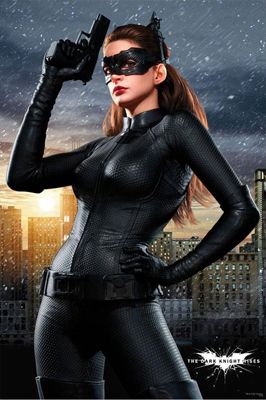Since today is my birthday it is lucky that I get to write about something I really like; Anne Hathaway's depiction of Catwoman in The Dark Knight Rises. With the release of the blu-ray next week (December 4th to be precise, in plenty of time for early holiday shopping), I had a chance to review it and check out all the special features that come with it. Since I'm sure you'll be able to find plenty of reviews of the entire, impressive package, I focused my attention on Catwoman and the feature elaborating on the design and approach taken on that character.
People have accused me of being a fan of the Nolan take on Batman, but even I had serious doubts when I heard that Hathaway was cast as the iconic Catwoman opposite strong actors like Christian Bale and Tom Hardy. I worried that this ridiculously perky young woman wouldn't be up to the task of depicting the strength and composure of Catwoman. I expected a train wreck, but I was pleasantly surprised by an athletic, clever, multi-dimensional depiction of the character, who was the equal of her male co-stars. Nolan and Hathaway managed to make Catwoman something she had never been before; plausible. She brought a combination of vulnerability and strength to the role which perfectly reflected and deflected Bale's depressed Batman. It was a pleasure to watch and even more fun to rewatch and get more background about the design of the character.
As with all superheroes and villains, the nature of the long-form, multiple-author stories, combined with the cross-genre depiction of the character, means that the Catwoman I see as the "real" Catwoman is subjective. The Selina Kyle who I've come to love over the years is an amalgam of inputs, but my perception of Catwoman was set up very early in my life by three of the depictions I first connected to, each one representing one of the three sides to her character:
1. Batman: Year One (by Frank Miller and David Mazzuchelli) introduces Catwoman as a classic cat burglar. Silent, skilled, athletic, and unseen. She is quite clearly a woman in a catsuit, a professional burglar who is always stealthy in her movements. She is a criminal, but one with certain scruples and standards. She has her own code of honor which she has been forced to live by.
2. Catwoman: When in Rome (by Jeph Loeb and Tim Sale) shows us a versatile, elegant, sophisticated adult woman, able to walk into any situation and make herself at home. Very much the superior femme fatale, she is always looking for her angle, for the way she can turn a situation to her own advantage. She displays a resourcefulness born from a desperation which can make her seem ruthless.
3. Detective Comics #569 - 574 (by Mike W. Barr and Alan Davis) gave us a glimpse into a world where Catwoman could be good for Batman, and become his counterpart. By embodying all of his qualities, but expressing them in an entirely different way, she can begin to open him up to happiness, to fighting the good fight, but still embracing life. Seductive where he is aggressive, amused where he is stoic, she gives him a new lease on life.
Looking to the television and movie representations of Catwoman, from Julie Newmar, to Lee Meriwether, to Eartha Kitt, to Michelle Pfeiffer we repeatedly see intelligent women acting like cats, and I mean literally pretending to be small, furry animals, licking themselves (and others.) This kind of caricature, while adorable and rather sexy, doesn't belong in a real world representation of a professional burglar. Of course I understand that nothing about superheroes belongs in the real world, but if you're going to get really into it and bring it all to a kind of pinnacle of realism (as I feel the newest trilogy of Batman films has done), then no professional criminal is going to be taken seriously if she is rubbing herself on strangers and making meowing noises. The last person to make this work was definitely Michelle Pfeiffer in Tim Burton's Batman Returns in 1992. While she talked a lot about wanting to be taken seriously and be as strong as a man in a man's world, she also licked milk out of a saucer and purred. While this behavior worked in the context of a very vampy Burton movie, her behavior wasn't actually an effective, real-world demonstration of equality.
The Dark Knight Rises presents us with possibly the least sexually-charged and least object-fetishizing (and possibly the least sexist) depiction of Catwoman and Batman on screen so far. Instead of a man and woman in skintight rubber, they read more as soldiers in battle-armor, engaged in a war against the raging, over-the-top masculinity of Bane. Neither of them are overtly sexual in any way, and it is to Nolan's credit that every aspect of Catwoman's costume and demeanor is as a result of practicality. While there are a slew of extra feature interviews, effects, and sketches, etc on The Dark Knight Rises blu-ray, there is one which focuses on Catwoman exclusively, explaining the function of the various aspects of her costume, the research Hathaway did to embrace her character, and both Christopher Nolan and Jonathan Nolan's take on it.
In the character feature about Catwoman, writer Jonathan Nolan describes lobbying for Catwoman's inclusion in the film; "You can't tell the story without that character." He understands that she is "the yin to [Batman's] yang." Director Christopher Nolan counters by describing his own reluctance to work with her; "It took me a while to find my way into that... Realizing that she could be this conwoman, grifter, classic movie femme fatale, that was the way in... It is very playful, it's a lot of fun. That's really what she's doing in the film. The film has a lot of miserable people in it, quite frankly, and she's not one of them."
Hathaway says that for her performance, she didn't look to any other actor's depictions of the character, since this had to be true to Nolan's vision, and instead looked to the comic books and one of Bob Kane's original inspirations for Catwoman - Hedy Lamarr - using the classic movie star's breath and poise as a guide for her own gait. In terms of Nolan's direction, she posits that "If you make any kind of easy or an obvious choice for the character, he will steer you away from that, because everything is real, everything is thoughtful.", which supports her performance as more of an actual woman and less of a wacky kitten than previous incarnations have been.
Nolan laudably looked for the motivation behind the cat aspect of the character, stating that "It was very important that there be a logic behind the different elements." Supported by costume designer Lindy Hemming and costume FX supervisor Graham Churchyard, Nolan endeavored to design cat ear goggles that Churchyard says were created to "look as if they'd been made by the police for night vision work." Hemming goes on to explain that "Catwoman hasn't got a sexual catsuit, she's got a practical catsuit which enables her to sort of disappear into the darkness, get wet, get cold, climb buildings... It's almost like James Bond's suit. Whatever she wears, she can go effortlessly into anywhere."
Even aspects of the costume as potentially impractical as high-heels are made an essential weapon in her arsenal, as Nolan explains; "Really trying to come up with functional ideas for the entire costume. With the boots for example, it was very important to me that they be these sort of knife blades, that they be serrated on the inside like a hunting knife and sharp on the outside, that they be very clearly and very obviously useful as weapons... You wanted her to have this incredible outfit, but you wanted to explain why she had it and what she could use it for." This kind of thoughtful, detail-oriented approach goes a long way towards legitimizing and reclaiming the power of a character who, over time, in the films and TV show, had drifted much too far into the arena of pointless fetishism. This is a radical change in direction, more faithful to past comic book depictions of Catwoman and Selina Kyle, and the film is that much stronger for it.




